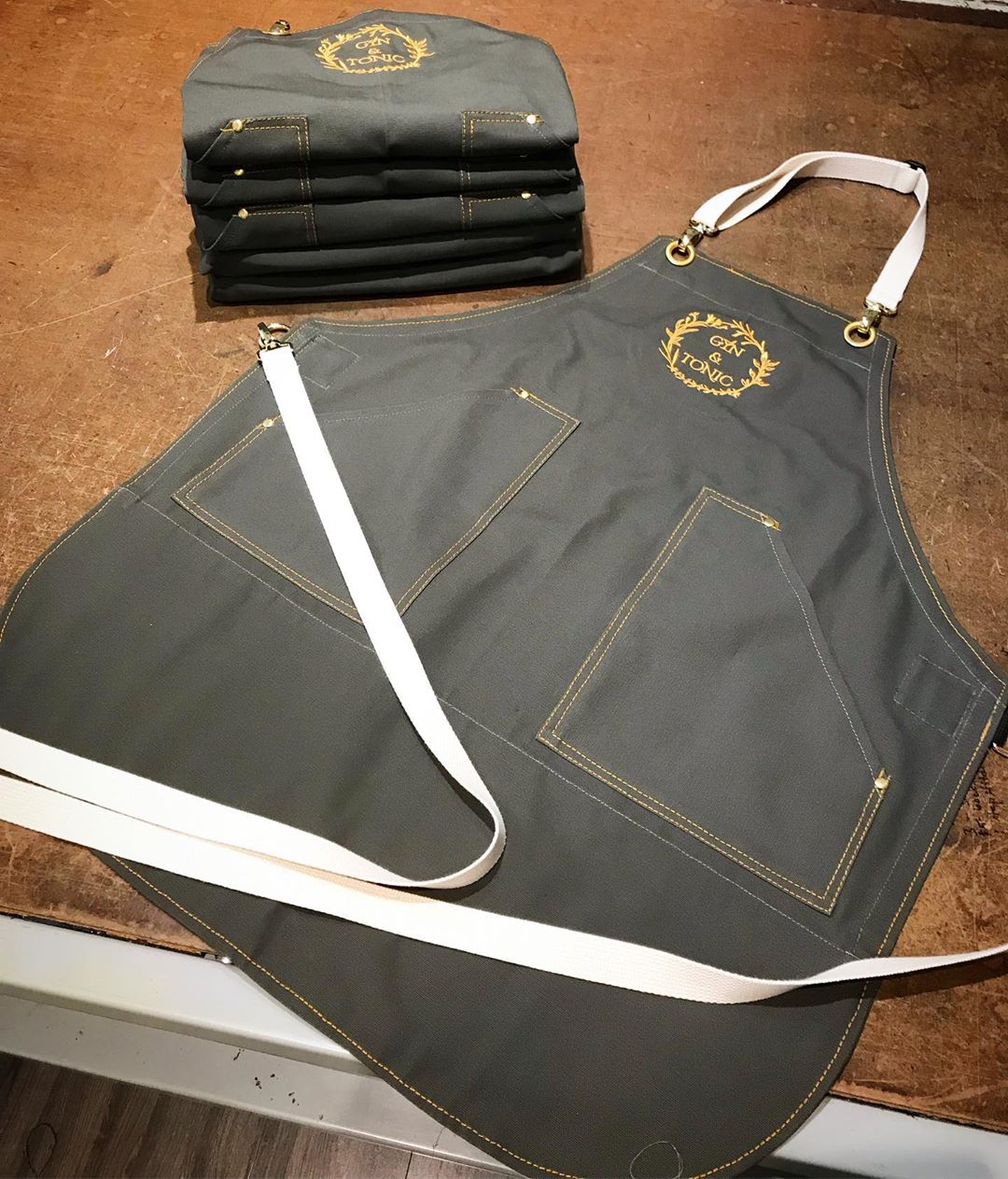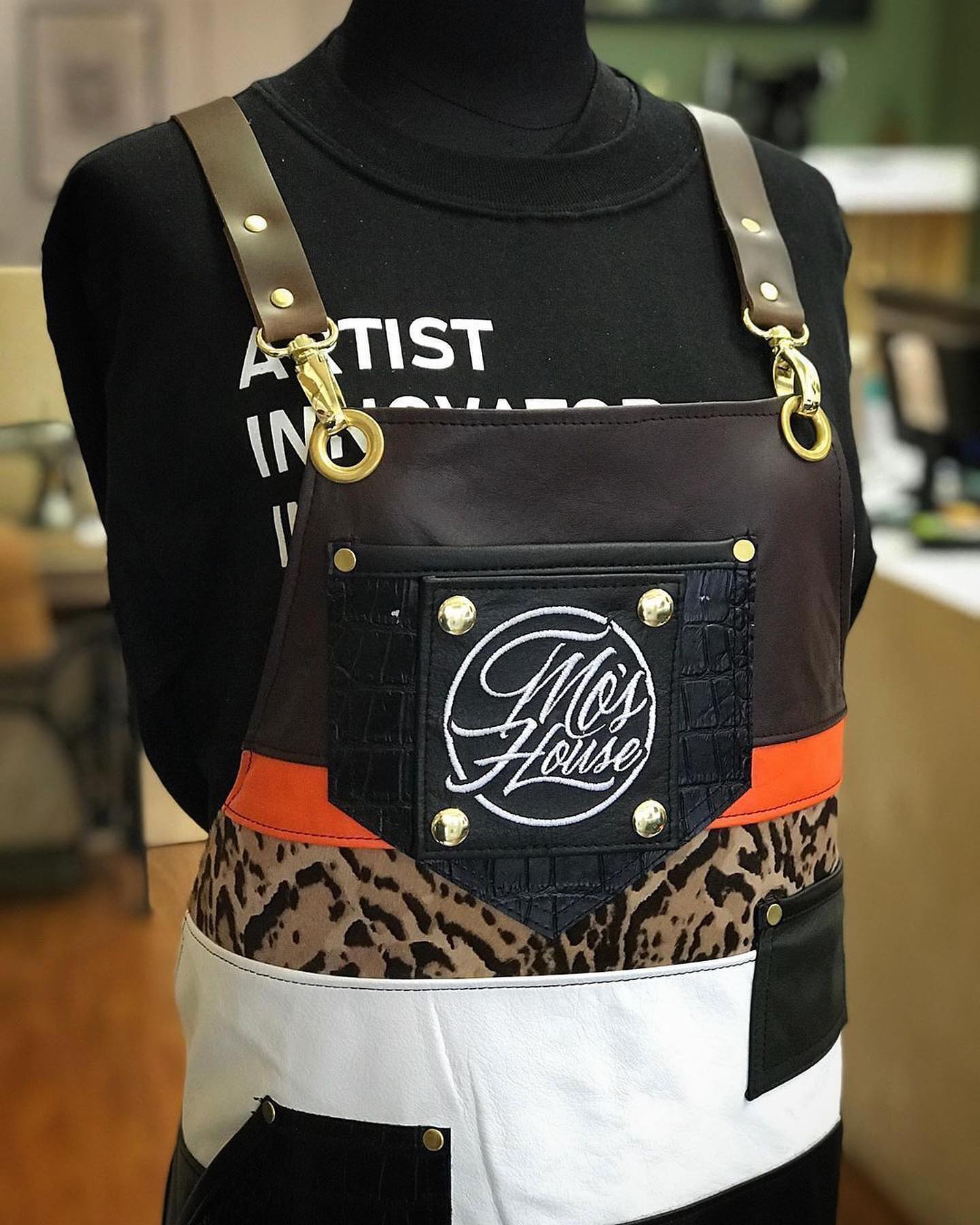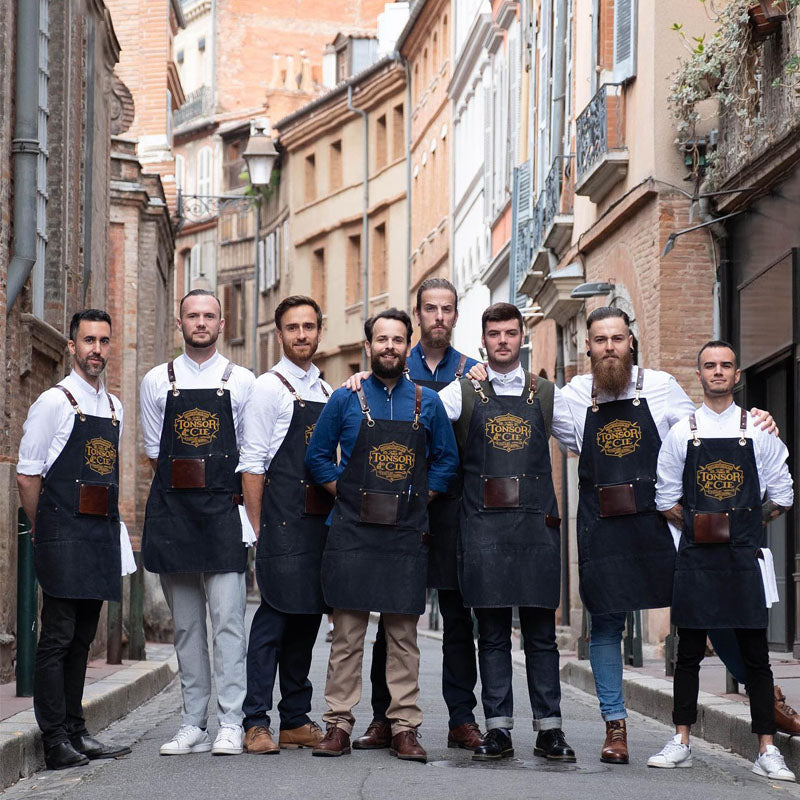At first glance, S&R’s business is aprons. We make products that keep our clients clean, organized, and stylish while they cook, style, bartend, craft, build, tattoo, serve, and more. In doing so, we also help them do their jobs better and more efficiently.
But our real business is branding.
As a work uniform, an S&R apron can enhance a business’s branding, whether that’s through the colour of the material, the embroidered, embossed, or silk screened logo, or by being a canvas for pins and other branded items. Every time a barber’s client sees them wearing an apron with the barbershop’s logo, the client is reminded of the business’s brand. Every follower who scrolls past a pic of a tattoo artist at work wearing their custom apron sees the name of the artist front and centre on the apron. Our aprons are integral parts of our clients’ branding.
That’s why we’ve put together this branding guide. We’re so passionate about building our brand and our tribe, and we want to help others do the same thing. If you’ve already got a killer brand then you can head straight to our custom apron builder and get an apron to match. But if you think your brand could use some improvement, read on!
We’ve put together this list of 80+ questions to help you think through your brand and how to make it more effective, impactful, and representative of you and your business.

Who is Your Target Market?
Your brand should be driven by the customers you want to reach. You can’t sell to everyone - successful businesses define the exact type of client they want to attract. Even if you have a pretty good sense of your ideal customer, it can still help to think through the details of who they are. Put yourself in your clients’ shoes and try to see your brand through their eyes.
- Is your brand driven by your business or your target customers? Ideally the answer is both, but think about where your brand is at right now.
- How does your ideal customer currently perceive your brand?
- Would you want to change anything about how they perceive your brand?
- How do they speak and think?
- What are their demographics? Age, gender, location, income level?
- What voice, style of language, or buzzwords will resonate with them?
- What colours, patterns, or other visuals will they be drawn to?
- What do they value? Tradition or trends? Quality or quantity? Minimalism or excess? Fun or formality?
- Are you selling business-to-business, or business-to-consumer? How does that impact your brand?
- What avenues are most effective for reaching your ideal customer?
- What other brands are they loyal to? What do you think they like about those brands?
- Do they have their own brands to consider? Depending on what business you’re in, your customers may want to align their branding with yours. If you’re a stylist or tattoo artist, you’re helping determine how your customers present themselves to the world. A bartender creates an environment where other businesses bring their clients. How are you helping them define their brand? How will they perceive your brand in relation to their own?
- What goes into their purchasing decisions, and how can your branding help them decide to purchase from you?
- How does your brand tell your customers that you are right for them?
- How does your brand make them feel comfortable and understood?
- How do you want people to feel when they see or think about your brand?
- How would you want your ideal customer to describe your brand to someone else?
- Why should they care about your brand?
- What will make them trust you?
- Has your target market changed over time? Is it still who you thought it was when you developed your brand initially?
- How successful has your brand been in attracting your ideal clients to date? Could you make small tweaks or big changes so its more effective?

What is Your Purpose?
Like we said, S&R’s real mission is to support our clients’ brands through custom aprons. It wasn't always that way: in the beginning, we were just making aprons. But over time, as our business has developed, we've reached a place where we know our actual purpose is to help build brands. Now it's your turn to think about your true mission, and how your brand supports it.- What led you to start your business in the first place?
- What is your business’s basic purpose? Cutting and styling hair, tattooing people, cooking, etc.
- What is your business’s true purpose? You cut and style hair, but you really make people feel beautiful, confident, and refreshed. You draw tattoos on people, but you really help them make a statement to the world about who they are, or you permanently imprint an important memory, milestone, or relationship in their life. You cook, but you really bring people together and nourish them over a shared experience. What do you really do?
- Right now, how well does your brand communicate your purpose?
- Does your brand specifically tell people what your purpose is or does it imply it?
- How could your brand better reflect your purpose?
- Has your purpose changed over time, and if so, did your brand change with it?
- Do you have a mission statement? If so, how does it drive your brand?
- Does your business have defined values? If so, are they reflected in your brand?

What Makes You Unique?
You probably have a general idea of how you’re different from competitors. Maybe it’s price, location, services, or products. Your brand should not only reflect those differences - your brand itself should be a differentiator.- Other people do what you do, so what makes you different?
- Who are your top competitors, and how are you specifically different from them?
- Does your brand communicate what makes you different?
- How do you communicate your unique benefits?
- Do you clearly spell out what makes you unique? Or do you just imply it?
- Is your brand unique within your industry or market?
- Are there things you could do more to differentiate your brand from competitors?
- What are you known for? Maybe you're a bartender with a magnificent mohawk or a hairstylist who loves her Skittles. How is your specialty incorporated into your brand?

How Can You Improve Your Visual Assets?
It’s worth taking the time to inspect each aspect of your visual brand - colours, logos, fonts, website, and social media accounts. Consider them each separately and together. It’s also worth having other people look at them and give you feedback - you can be so immersed in your own brand that it can be hard to see it yourself. Someone else’s fresh eyes can identify things you may have overlooked.- What impact do your visual assets have on a potential customer seeing them for the first time?
- Scroll through your social media feeds - can you immediately see your brand through the pictures you post?
- Does your logo easily communicate your brand?
- Do you have multiple versions of your logo (ie, square, rectangular, circular) so that there's an ideal format for different uses?
- Did you select the fonts on your website, or did you use the default? Could you pick a font that better matches your brand?
- Do you use colours consistently, or haphazardly?
- Do you have main and accent colours?
- If you added or removed colours from your brand palette, would that improve your brand?
- Do your visual assets work in harmony? Or is there an element or two that stands out and doesn’t match the others?
- Have someone else look at your visual assets and tell you what they see. When they describe what they see, does it sound like they understand what you were going for? Or could you make improvements?
- Could your visual assets use a refresh? Sometimes a few little tweaks can make all the difference.
- Do you need professional help? If your brand has been DIY for as long as its existed, consider bringing in a pro to assist.
- Do your visual assets make sense? Whatever colours you use, text should always be readable on your website. And the font in your logo may look great as a logo but is illegible as blog headers. Work your assets together in a way that enhances your brand while still being user friendly.

What is Your Brand’s Voice?
If you don’t think about your brand’s voice, it’s going to end up sounding like the default style of the person who writes your copy. That might be okay! But it should be a conscious choice. It’s really important to consider what your brand sounds like to potential customers so that it resonates with them and makes them feel how you want them to feel about their brand.- Does your brand sound like you personally? Do you want it to?
- Is your brand sarcastic? Enthusiastic? Kind and relaxing? Straightforward and no-nonsense? Intellectual? Professional? Edgy? Maybe it’s a mix of several of these things, or something else entirely.
- If your brand was a person, how would it talk?
- How closely do you review your content for voice style? When writing content - whether that’s an Instagram caption, an overview of your services, or a blog post - it’s helpful to write a draft, then go back and see where you can tweak the language to ensure it’s on brand.
- How consistent is your brand voice? Consistency is important! It helps people recognize your brand when they see it.
- Do you have taglines, and do they reflect your brand?
- Do you have certain phrases that you often use to describe your business? Do they communicate your brand?

How Do You Put Your Branding to Work?
If you’re going to put the effort in to create an effective brand, you’ve gotta show it off to the world! Put your brand to work by making sure it’s front and centre on every aspect of your business. Every single touchpoint a customer has with you should somehow have your branding incorporated into it.- Is your brand integrated into every aspect of your business?
- How recognizable is your brand? If you had a booth at an industry trade show, and one of your customers walked by, would they instantly know it was you? When your customers are scrolling through Instagram, do they know it's you right away when they’re looking at your post, if they didn’t see your name?
- Do your logo or colours show up in every social media post? (If you get a custom branded apron, every time you post a picture of yourself at work on Instagram, people see your logo!)
- What are the touchpoints a customer has with you, and how can you integrate your brand into every touchpoint? When a customer receives your product in the mail, does the packaging make it obvious it came from you? When a customer receives an email reminding them of their appointment with you, does the colour and typography clearly show your brand?
- If your business has a physical space, how is your branding reflected there?
- Do you and your employees wear uniforms, official or otherwise? How is your branding reflected on them? (And could your uniforms improve with custom branded aprons?)
- Does your advertising reflect your brand?
- Do your advertising methods reflect your brand? You can spend your advertising dollars in a thousand different places - do you choose avenues that reflect your brand?
- How does your target market find you? Is it through search engines, social media, a physical location or somewhere else? Wherever your ideal customers are finding you is a place you should ensure your branding is well-utilized.
- Do you think about branding when you make business decisions? It can be helpful to consider your brand when weighing options.

How Do You Take Inspiration from Others?
It’s always useful to look around at what other people are doing. Within your industry, you want to be aware of your competitors and your partners, to ensure you’re standing out. Outside of your industry, you can take inspiration from others and look for innovative ways to improve your branding.- What are your competitors doing? How have they defined their brands?
- What do you like and dislike about your direct competitors’ brands? Are they consistent? Is it clear who they’re trying to target? How can your brand be better than theirs?
- What are brands in other parts of your industry doing? Consider those who may be striving for a similar look and feel as you. Maybe a florist takes inspiration from a wedding decorator, a hairstylist takes inspiration from a spa, or a bartender takes inspiration from a liquor company.
- Do you notice any obvious trends among brands in your industry? If so, do something different and set yourself apart!
- What do you not want for your brand? If you’re not sure where your brand is heading, it can be helpful to know what you don’t want. Try looking at brands from totally unrelated industries, to see what else is out there and help narrow your focus.
- Have you copied someone else’s brand? If so, change that now! Not only could you get in trouble if their brand is protected, it’s not authentic to your business. More than anyone else, your brand needs to resonate with YOU. It needs to come from you. If you copy someone else, it’s not truly your brand. When you’ve developed your brand, you’ll connect with it in a way that will allow you to grow it and manage it and keep it as a living, breathing part of your business. Don’t risk that by copying someone else.
- What brands are you loyal to, and why do you like them? Do you make a daily visit to Starbucks? If so, it’s probably not just about the coffee. What do you connect with in that experience? If you’ve been wearing the same brand of sneakers for years, comfort and style are probably part of that, but what does the brand say about you? What do you tell the world when you wear those sneakers? And chances are, you buy them at the same place or from the same website - why do you enjoy that process? Sure, sometimes we purchase things in spite of the buying experience, because the product is just that special, or the price is extra low, but it’s likely that that is rare. It’s much more common to make buying decisions because of the entire experience, and that experience is driven by brand. Take your personal brand loyalty and think about how to use that to improve your business's brand.

A Few Big Picture Questions
We’ll wrap up with a few questions to make you think about where your brand has been and where it’s going.- Do you have brand extensions to consider? If not, would you want to do some in the future? For example, a hair stylist may want to start teaching classes, partnering with products, or creating a separate arm of their business for wedding or special event hair. These brand extensions create extra revenue streams, and they also require flexibility and careful consideration of how the brand is used across parts of the business.
- When was the last time you worked on your brand? Is it constantly evolving, or does it become stagnant at times? How could you ensure it is always iterative?
- Do you have a brand strategy? Ideally you’ll have written brand guidelines as well as goals for your brand.
- Can you describe your brand in a paragraph, sentence, or single word?
- Five years from now, what do you want your business to look like? How does your brand fit into that?
Thanks for reading S&R’s brand guide! We’re always here to help you with your branding. Check out our Wholesale & Branding page, or head to our custom apron builder to see what we can create for you. You can also check out our Ambassadors page to see some folks who've built some pretty great brands for themselves. And if you want more info on what we do, get in touch!
S&R Apron Co. makes the best quality denim, canvas, leather, and vegan leather aprons. We make aprons for talented and passionate people creating incredible art, businesses, brands, and lives. All aprons are handmade in Vancouver, Canada.
Barber/Hairstylist Collection | Kitchen Hospitality Collection | Artist/Maker Collection
We believe that the best apron is the one made just for you. You can use our Custom Apron Builder to create an apron that meets your exact specifications.
Follow us: Instagram | Facebook | Pinterest | TikTok | Linkedin
Take your business branding to a new level with our wholesale for teams. Use our Custom Apron Builder or choose from our catalogue, and we'll give you a deal on a bulk order.
For any questions, contact us, or check out our FAQ page.





